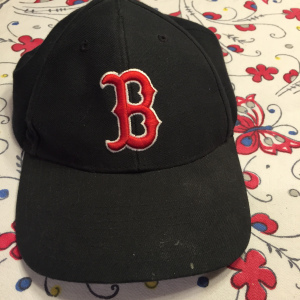Sherry Harris's Blog, page 22
April 24, 2015
Cook Like a Mystery Writer
Edith here, getting ready for the Newburyport Literary Festival tomorrow (with Jessie and 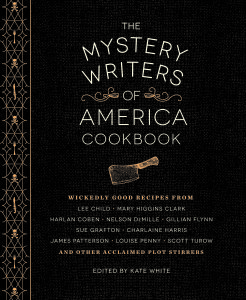 Liz), and Malice soon after!
Liz), and Malice soon after!
Mystery Writers of America and Quirk Books recently published a gorgeous hardcover cookbook, edited by Kate M. White. It includes scrumptious recipes from luminary Sisters in Crime like Katherine Hall Page, Louise Penny, Sue Grafton, and Sara Paretsky; authors like Lee Child, Joe Finder, and Harlan Coben; and best-selling writer pals of ours like Hallie Ephron, Hank Phillippi Ryan, Wicked Cozy Accomplice Sheila Connolly, and Leslie Budewitz. Barb and I each have a recipe in the book, too!
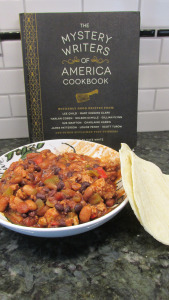 I made Charlaine Harris’s Very Unsophisticated Supper Dip last Saturday and it was delicious. I modified Charlaine’s recipe, adding fresh red and green peppers, and we ate it with warmed fresh corn tortillas instead of tortilla chips. It was a fabulous cozy dinner in front of a movie. So far I’ve also made Barb Ross’s recip
I made Charlaine Harris’s Very Unsophisticated Supper Dip last Saturday and it was delicious. I modified Charlaine’s recipe, adding fresh red and green peppers, and we ate it with warmed fresh corn tortillas instead of tortilla chips. It was a fabulous cozy dinner in front of a movie. So far I’ve also made Barb Ross’s recip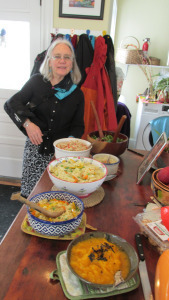 e, invented by her husband Bill Carito, a fabulous Lobster-Pesto Risotto that was perfect for our Easter brunch (somehow I failed to get a closeup of the dish, but it was a big hit with our guests).
e, invented by her husband Bill Carito, a fabulous Lobster-Pesto Risotto that was perfect for our Easter brunch (somehow I failed to get a closeup of the dish, but it was a big hit with our guests).
I’m running a contest to give away a copy of the cookbook. All you have to do is leave a comment over on the contest link on my web site (http://edithmaxwell.com/mwa-cookbook-contest/) before sundown tonight, Friday April 24! Or heck, a comment here will enter you, too!
Readers: Hungry yet? What author do you hope you’ll find in the cookbook? Have you tried any of the recipes yet?
Filed under: Contests, Edith's posts Tagged: Bill Carito, Charlaine Harris, giveaway, Hallie ephron, Lobster Risotto, MWA Cookbook, Mystery Writers of America

April 23, 2015
Favorite Malice Moments
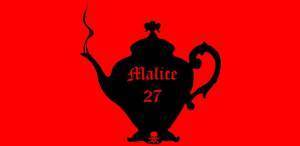 We are very excited that Malice Domestic 2015 is just one week away, and it’s in its twenty-seventh year! So today we will share some of our favorite Malice moments — take it away, Wickeds.
We are very excited that Malice Domestic 2015 is just one week away, and it’s in its twenty-seventh year! So today we will share some of our favorite Malice moments — take it away, Wickeds.
Edith: Wow. So many favorite moments. I roomed with Sherry my first Malice, and stayed at her home the night before and the night after (watching the royal wedding on TIVO, I might add). I didn’t have a book out yet, but I loved being immersed in all those authors and all those fans! In 2013, I was a debut author with Speaking of Murder, and hosted a table at the New Authors’ Breakfast. What a treat to have Catriona McPherson at my table – Catriona w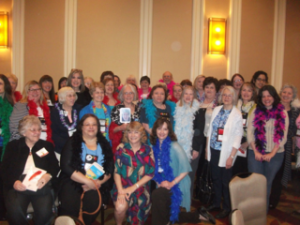 ho had just won an Agatha award the night before. Afterwards she pulled me aside and said she also held a PhD in linguistics. Man, this debut author was SO delighted. Then last year at the Sisters in Crime breakfast, the number of Guppies present, most wearing boas, took two photographs to capture us all. But this year, being an Agatha nominee for Best Short Story? I’m not sure I’ll be able to handle the excitement! At least I’ll have my lifeboat with me – the other five core Wickeds and all three of our Accomplices, too.
ho had just won an Agatha award the night before. Afterwards she pulled me aside and said she also held a PhD in linguistics. Man, this debut author was SO delighted. Then last year at the Sisters in Crime breakfast, the number of Guppies present, most wearing boas, took two photographs to capture us all. But this year, being an Agatha nominee for Best Short Story? I’m not sure I’ll be able to handle the excitement! At least I’ll have my lifeboat with me – the other five core Wickeds and all three of our Accomplices, too.
Barb: My favorite Malice moment involves a core group of the Wickeds and accomplices. My first book, The Death of an Ambitious Woman, was published in hardcover by a small press. Of course, I was thrilled to be on a panel at Malice and to have a signing. HOWEVER, at the signing, I was seated next to Maggie Sefton, who had a line that trailed off the signing platform, down the stairs and out into the lobby. Some of the Wickeds–Sherry, Kim & Edith–loyally went through my signing line–even though they already had my book. Then, they took one look at me sitting all alone while Maggie Sefton signed and signed–and they went through my line again! And again! Such loyalty. Such sisterhood.
Edith: Aw, total no brainer, Barb! And what goes around, comes around.
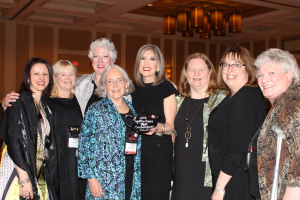 Julie: At the risk of being a sap, my favorite Malice moment was that I met Sherry Harris. I was at the banquet, and was the table host. Sherry was seated at my table. If you have had the pleasure of meeting Sherry, you know that she is one of the loveliest people around. She mentioned that she was moving to Massachusetts, I told her to join Sisters in Crime, and the rest is history. I have many wonderful Malice moments (it is a great conference), but I suspect that sitting at the banquet with Sherry this year will be another one–so happy for my friend, and her well deserved Agatha nomination for Best First.
Julie: At the risk of being a sap, my favorite Malice moment was that I met Sherry Harris. I was at the banquet, and was the table host. Sherry was seated at my table. If you have had the pleasure of meeting Sherry, you know that she is one of the loveliest people around. She mentioned that she was moving to Massachusetts, I told her to join Sisters in Crime, and the rest is history. I have many wonderful Malice moments (it is a great conference), but I suspect that sitting at the banquet with Sherry this year will be another one–so happy for my friend, and her well deserved Agatha nomination for Best First.
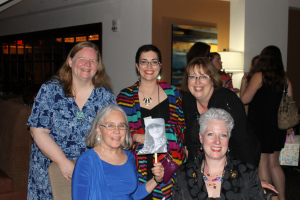 Liz: Last year was my very first Malice (unless you count the prior year when I went on a stick) and all I remember is what a whirlwind it was! Kneading to Die was a best first Agatha nominee, so it was like induction by fire. All the Wickeds being there together was awesome and so much fun. Meeting some readers who are regulars on my Facebook page was very cool too. I can’t wait for this year!
Liz: Last year was my very first Malice (unless you count the prior year when I went on a stick) and all I remember is what a whirlwind it was! Kneading to Die was a best first Agatha nominee, so it was like induction by fire. All the Wickeds being there together was awesome and so much fun. Meeting some readers who are regulars on my Facebook page was very cool too. I can’t wait for this year!
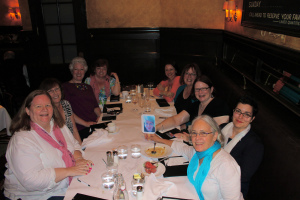 Jessie: My favorite moment occurred last year when I was able to thank Dorothy Cannell for being so kind to me when I met her years earlier at an author event in Maine. I stepped up to the front of her book signing line to ask her to autograph her latest mystery and then managed to gather all my courage in two hands and choke out the news that I had written some books of my own. She was, of course, gracious, and generously asked me to autograph one of my books for her. I was so touched! I think one of the very best things about the mystery community is how supportive and kind everyone is to each other.
Jessie: My favorite moment occurred last year when I was able to thank Dorothy Cannell for being so kind to me when I met her years earlier at an author event in Maine. I stepped up to the front of her book signing line to ask her to autograph her latest mystery and then managed to gather all my courage in two hands and choke out the news that I had written some books of my own. She was, of course, gracious, and generously asked me to autograph one of my books for her. I was so touched! I think one of the very best things about the mystery community is how supportive and kind everyone is to each other.
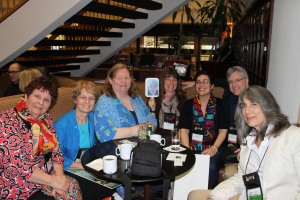 Sherry: I went to my first Malice in 2003 so I have a lot of favorite moments! In 2004 I was checking in at the same time as an agent and she told me to send her my manuscript. I did and it was rejected but still… And who can forget the year Louis Farrakhan was staying at the same hotel! As Julie said our meeting was momentous and life changing for me in so many ways. I blogged about it when I talked about the importance of networking. I’ve met so many wonderful people at Malice and that is really the best part about going. Last year I moderated my first panel — that was so much fun — thank you Barb Goffman for trusting me with the Here Comes the Corpse panel! It will seem as if my Malice life has come full circle having Julie next to me at the banquet this year. Being nominated for an Agatha Award is like the icing on the Malice cake for me.
Sherry: I went to my first Malice in 2003 so I have a lot of favorite moments! In 2004 I was checking in at the same time as an agent and she told me to send her my manuscript. I did and it was rejected but still… And who can forget the year Louis Farrakhan was staying at the same hotel! As Julie said our meeting was momentous and life changing for me in so many ways. I blogged about it when I talked about the importance of networking. I’ve met so many wonderful people at Malice and that is really the best part about going. Last year I moderated my first panel — that was so much fun — thank you Barb Goffman for trusting me with the Here Comes the Corpse panel! It will seem as if my Malice life has come full circle having Julie next to me at the banquet this year. Being nominated for an Agatha Award is like the icing on the Malice cake for me.
Readers: Any favorite Malice moments of your own? How about questions on the order of, “What the heck is Malice? And what do you do there?”
Filed under: Group posts Tagged: Agatha awards, Best First Novel, Book signings, Catriona McPherson, Dorothy Cannell, Favorite Malice Moments, Maggie Sefton, Malice Domestic, networking, New Authors Breakfast

April 22, 2015
Wicked Wednesday — Earth Day
 By Sherry, enjoying all of the flowering trees in northern Virgina
By Sherry, enjoying all of the flowering trees in northern Virgina
As I was setting up this post I realized I didn’t know a lot about the history of Earth Day so here is a little information from the earthday.org website:
The idea came to Earth Day founder Gaylord Nelson, then a U.S. Senator from Wisconsin, after witnessing the ravages of the 1969 massive oil spill in Santa Barbara, California. Inspired by the student anti-war movement, he realized that if he could infuse that energy with an emerging public consciousness about air and water pollution, it would force environmental protection onto the national political agenda. Senator Nelson announced the idea for a “national teach-in on the environment” to the national media; persuaded Pete McCloskey, a conservation-minded Republican Congressman, to serve as his co-chair; and recruited Denis Hayes as national coordinator. Hayes built a national staff of 85 to promote events across the land.
To find out more about the history of Earth Day click on this link.
So Wickeds what do you do to help preserve our environment?
Jessie: When my husband and I bought our first house twenty years ago we started
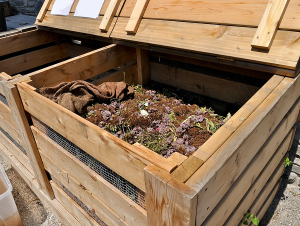 composting everything we possibly could. Not only has that helped the environment by reducing our weekly garbage volume by at least half, it has yielded such a wonderful amendment for our garden beds. I hope that by raising our kids with the composting habit, they will do the same in their own households one day.
composting everything we possibly could. Not only has that helped the environment by reducing our weekly garbage volume by at least half, it has yielded such a wonderful amendment for our garden beds. I hope that by raising our kids with the composting habit, they will do the same in their own households one day. Edith: I do as much as I can except turn the water off while I’m brushing my teeth. We compost all food scraps except meat and recycle everything possible, resulting in one small grocery bag of actual trash every week. I use rain barrel water for the garden, print drafts on the back of previously printed drafts, and drive a Prius with very conservative driving habits. I walk everywhere within a mile of home.
Edith: I do as much as I can except turn the water off while I’m brushing my teeth. We compost all food scraps except meat and recycle everything possible, resulting in one small grocery bag of actual trash every week. I use rain barrel water for the garden, print drafts on the back of previously printed drafts, and drive a Prius with very conservative driving habits. I walk everywhere within a mile of home.We
 super-insulated our walls and ceilings and installed an efficient gas boiler and an on-demand water heater. On the other hand, I refuse to sit around my house with a hat and mittens on in the winter, so we do turn the thermostat up to 70. But see item about insulation… I’m sure I could do more, like ride my bike everywhere within five miles, or capture warming-up shower water for the garden or toilet. I have my limits, though. And I live in a very hilly town. Now if I lived in California…
super-insulated our walls and ceilings and installed an efficient gas boiler and an on-demand water heater. On the other hand, I refuse to sit around my house with a hat and mittens on in the winter, so we do turn the thermostat up to 70. But see item about insulation… I’m sure I could do more, like ride my bike everywhere within five miles, or capture warming-up shower water for the garden or toilet. I have my limits, though. And I live in a very hilly town. Now if I lived in California…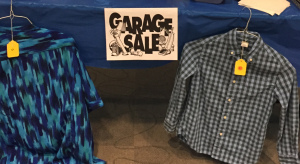 Sherry: It will surprise no one that I think garage sales are one of the best way to recycle things. If you don’t like garage sales it’s easy to contact a charitable organization to come pick up things you don’t want anymore. Or you can take them to your favorite thrift shop. Nothing drives me more nuts (okay, my husband occasionally does) than seeing useable items set out on the curb for garbage. And, yes, I’ve rescued my share of things from the curb.
Sherry: It will surprise no one that I think garage sales are one of the best way to recycle things. If you don’t like garage sales it’s easy to contact a charitable organization to come pick up things you don’t want anymore. Or you can take them to your favorite thrift shop. Nothing drives me more nuts (okay, my husband occasionally does) than seeing useable items set out on the curb for garbage. And, yes, I’ve rescued my share of things from the curb.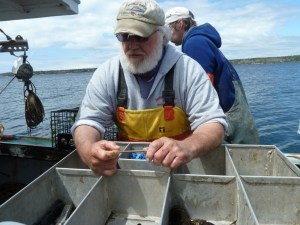
Captain Clive Farrin explains how to measure the lobster. In Maine legal lobsters must be between 3 1/4 and 5 inches long on the carapace (from the eye socket to the start of the tail). Larger and smaller lobsters must be thrown back.
Barb: I can’t say we do anything extraordinary. We’re regular recyclers and our Massachusetts house is very efficient having been totally gutted and rebuilt ten years ago. We drive a small, fuel-efficient car. But all that just seems like common sense in cold, densely-populated New England. So instead, let me talk lobsters. I did a lot of research about lobsters and lobstermen (which is what they are called, even when they are women) for Musseled Out, the Maine Clambake book that comes out next week. I came away so impressed. The lobstermen of Maine take huge responsibility for the fishery. They’ve watched fish stocks collapse around them and they know the consequences to their living if it happens with lobsters. They can’t and don’t take lobsters that are too small or too big, and if they catch an egg-bearing female, she is notched with a V on her tail, so she can’t be taken even when she isn’t bearing eggs. The lifecycle of lobsters is complicated and poorly understood. The tiniest hatchlings (super lobsters) can drift for miles and miles before they settle on the bottom. As a result, the lobstermen and the Federal government have had many disagreements about how to preserve the fishery. But the lobstermen, who are all small businessmen, not corporations running giant ships, and who observe the fishery daily, have been consistently right. Now they are under threat from things far beyond their control–the warming and increasing acidity of the North Atlantic. Already the lobsters have moved northward and the shell disease that has devastated southern New England has crept into Maine. We’ll see what happens.
Julie: My house is energy efficient, I recycle, and I try to get foods and products that are good for the environment. But the biggest thing I do is that I rarely drive. I live in Somerville, so I get places by taking buses and trains. And I walk. A lot. Over 10,000 steps a day on average. I have not made the car free leap yet. but I drive under 4000 miles a year.
Liz: We’re big recyclers too. I wish I could say I didn’t have to drive much, but I do. I try to do little things, like pick up trash when I’m out walking, or participate in volunteer projects through my work to help beautify local parks or other areas.
Readers, what do you do to conserve the environment? How will you celebrate Earth Day?
Filed under: Wicked Wednesday Tagged: composting, Earth Day, garage sales, lobsters, musseled out, Prius, recyling

April 21, 2015
The Detective’s Daughter : Book ’em!
By Kim enjoying spring in Baltimore
I come from a family of readers. Whether it was The Sun, a case file, or a John le Carre
novel, the written word was present in our everyday life. My grandfather carried the sports page folded in the back pocket of his pants. Dad enjoyed pouring over his case notes with us at dinner, while Mom kept her nose firmly planted in the latest mystery she’d borrowed from the Enoch Pratt Library. I remember the first book I picked out on my own. It was at a tiny bookstore near Lexington Street, in the heart of the downtown shopping district. My Mom was buying a present for a friend and agreed to buy one book for me. I chose a collection of fairytales illustrated by Tasha Tudor. I still have it and read the stories to my own children. It was the beginning of  my love affair with Tasha Tudor and also became the first entry in what would become my book list obsession.
my love affair with Tasha Tudor and also became the first entry in what would become my book list obsession.
For more years than I care to count I have kept a notebook with lists of books that I have either read or wish to read. Several list contain many of the same titles. There was a time – before having children – I categorized my list in very specific genres. Mystery headed the column that included cozy, thriller, procedural, super natural and true crime. Even self-help was broken down to numerous categories. Obviously, I needed a lot of help or at the least, something better to occupy my time. Think of all the books I could have read instead of writing their titles on a list!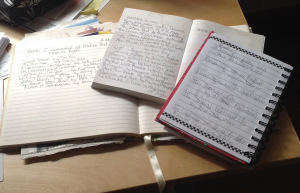
The one list I should have worked on, and never did, was that of people who borrowed my books. There are quite a few books I’m sure I will never see again. For the last year I’ve been part of a book club that meets once a month. We’ve read some wonderful stories, many of them I would never have chosen. A few of the books have been on one of my lists and it gives me great satisfaction crossing that title out.
This year I have begun a new journal. It’s really my first official book journal in a fancy notepad and not just some loose leaf paper haphazardly stapled together. I now rate the books I read with stars and leave spaces for comments. I enjoy talking about books and especially enjoy reading blogs such as Dru’s Book Musings. This summer’s goal, at least one of them, is to read the forty books Ramona DeFelice Long recommended on her blog during her forty days of women authors. I am nearly finished reading the nominees for the Agatha Awards to be given at Malice Domestic this year. Two of our own Wickeds, Sherry and Edith, are up for best first novel and best short story.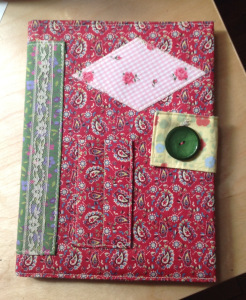
I leave you now gentle reader as I head out to my sunny porch to put a dent in yet another book, and I would like to know what kind of lists you keep. Do they serve as inspirations or as yet another chore?
Filed under: The Detective's Daughter Tagged: Baltimore City, Baltimore City Police, Dru's Book Musings, Enoch Pratt Library, Malice Domestic, Tasha Tudor, The Detective's Daughter

April 20, 2015
And the winner is…
We have so much fun with our Stick with the Wicked Contests! It started two years ago when Liz couldn’t go to Malice with the rest of us. Then I got to go with the Wickeds (on a stick) to Bouchercon in Albany. When we realized we’d all be at Crime Bake the contest was born. Our first winner was Barb Goffman, followed by Reine Carter and Dru Ann Love. Who will it be this year? Drum roll please!
First we pulled out the trusty Boston Red Sox hat.
Then we fill it with the names of everyone who entered.
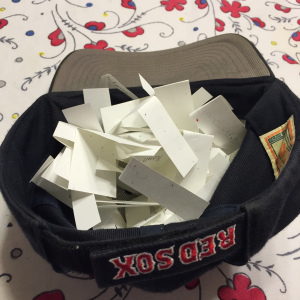 We get a third, non-interested party to pull the name.
We get a third, non-interested party to pull the name.
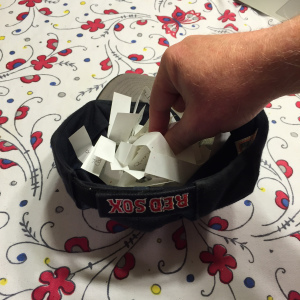 And finally the suspense is over!
And finally the suspense is over!
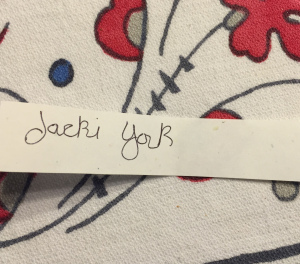 Congratulations, Jackie York! Jackie, go to the Malice Domestic website and pick the five authors (not including the Wickeds) you’d like a photo with and autograph from. We will make every attempt to track that person down. Please contact Jessie at jessie@jessiecrockett.com for further details.
Congratulations, Jackie York! Jackie, go to the Malice Domestic website and pick the five authors (not including the Wickeds) you’d like a photo with and autograph from. We will make every attempt to track that person down. Please contact Jessie at jessie@jessiecrockett.com for further details.
Filed under: Contests Tagged: Malice Domestic, Stick with the Wickeds

April 17, 2015
Welcome Back, Kate Flora!
by Barb, who is currently serving on a jury in a criminal case
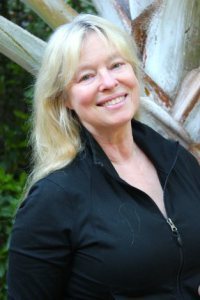 When Kate Flora visited us back in July, she was here to talk about her short story, “Girls Night Out” published by the new venture Shebooks.
When Kate Flora visited us back in July, she was here to talk about her short story, “Girls Night Out” published by the new venture Shebooks.
Now Kate’s back to talk about Death Dealer, her true crime book, which has been nominated for an Agatha Award for non-fiction.
Here’s the description of Death Dealer: How Cops and Cadaver Dogs Brought a Killer to Justice.
Death Dealer is a gripping true crime story of committed investigators from two countries and their cooperation in the relentless pursuit of a brutal murderer. It’s intriguing from the moment David Tanasichuk reports his wife, Maria, missing. Explaining the ten-day delay in notifying authorities, David claims that he and Maria were having marital troubles and she had decided to take a break by leaving town. Suspense builds as lie after lie unravels. David’s reputation for violence and drug abuse makes investigators take his veiled threats against them seriously.
Local police, frustrated by a fruitless wintertime search through miles of frozen wilderness, finally enlist the aid of Maine game wardens along with cadaver dogs and their dedicated volunteer handlers. This Law and Order meets CSI drama culminates in a riveting courtroom drama.
Barb: Welcome back, Kate. Your previous true crime book, the Edgar-nominated Finding Amy, scared the stuffing out of me, and not only because I had a daughter who was Amy St. Laurent’s age when I read it. After you finished that book, you vowed, “never again.” What was so compelling about the story behind Death Dealer that you broke your promise?
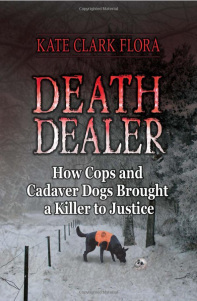 Kate: What I realized, a year or so after finishing Finding Amy and vowing never again, was that the writing life is a very solitary one, while the researching life, particularly when it involves a lot of contact with experts, can be interactive and fascinating. At the launch party for Finding Amy, the Maine warden lieutenant, Pat Dorian, had said, “So, when you’re ready, Kate, I have another one for you.” So I called him up and asked him to tell me about the case.
Kate: What I realized, a year or so after finishing Finding Amy and vowing never again, was that the writing life is a very solitary one, while the researching life, particularly when it involves a lot of contact with experts, can be interactive and fascinating. At the launch party for Finding Amy, the Maine warden lieutenant, Pat Dorian, had said, “So, when you’re ready, Kate, I have another one for you.” So I called him up and asked him to tell me about the case.
That led me on a series of hellish drives up to northeastern New Brunswick, Canada, but the people there were so open and welcoming, and I was quickly convinced, as with Amy St. Laurent, that Maria Tanasichuck’s story—and the story of the officers dedicated to getting her justice—really mattered.
Then I had a conversation with a New York agent who specialized in true crime, and when I told him the story, including the part where the bad guy starts stalking the police and their families, he said I should go find a better story, that no one was going to be interested in reading about a small town Canadian crime. Stubborn Yankee that I am, that was all it took to ensure I’d write the book.
Barb: Death Dealer is the story of the search for Maria Tanischuk’s body and the Maine Game Wardens and cadaver dogs who aid the Canadian authorities. What was the most surprising thing you did to research this book?
Kate: Good question. Certainly among the things that were new and different were:
Hiding in the mosquito-filled spring woods on a cadaver and search dog training, waiting to be found. Luckily, I only had to be lost. I didn’t have to be a cadaver.
Driving an ATV deep into the Canadian woods to view the spot where Maria’s body was found. First time on an ATV. We’ll skip the part involving the emergency room.
Going on a stake out with the Miramichi police, and being the one to spot the thief.
Barb: And on the flip side, what is the most surprising thing you learned as you researched this book?
 Kate: I’m not sure you’d call it surprising, but what I learned was that you can have a whole room full of interviews, and criminal records, and photographs, and data, but it still takes storytelling skills to figure out how to present that in a way that will make people want to read the book, care about the characters, and keep turning the pages. So what did I learn? I learned that writing fiction has taught me a great deal about how to write nonfiction, and I learned that spending time in the real world of crime and law enforcement has helped me make my police procedural fiction deeper and more authentic.
Kate: I’m not sure you’d call it surprising, but what I learned was that you can have a whole room full of interviews, and criminal records, and photographs, and data, but it still takes storytelling skills to figure out how to present that in a way that will make people want to read the book, care about the characters, and keep turning the pages. So what did I learn? I learned that writing fiction has taught me a great deal about how to write nonfiction, and I learned that spending time in the real world of crime and law enforcement has helped me make my police procedural fiction deeper and more authentic.
Barb: You write both fiction and non-fiction. I’m sure you could write a book about the differences, but I wonder about your mindset. In a nutshell, as you go to your desk every day, what is the difference between making stuff up and uncovering the truth? What is similar?
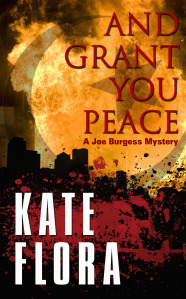 Kate: What is different? That in writing fiction, I control the characters. I shape them, I give them voices, I direct their actions. In writing nonfiction, I have to learn who the characters are and show them to a reader. It sounds simple. But when you know that real people will be reading the book, it creates a lot of pressure.
Kate: What is different? That in writing fiction, I control the characters. I shape them, I give them voices, I direct their actions. In writing nonfiction, I have to learn who the characters are and show them to a reader. It sounds simple. But when you know that real people will be reading the book, it creates a lot of pressure.
What is similar? Either way, I have to make the reader care. I have to make the reader see, feel, inhabit the story. Because either way, it’s storytelling.
Barb: What are you working on now?
Kate: Well…I’m doing the happy dance right now because another one of my nonfiction projects—a collaboration with a retired Maine game warden on his memoir, has just sold. Another fascinating adventure in the world of law enforcement, A Good Man with a Dog is the story of a challenging twenty-five year career in a job where everyone carries a gun. It’s got animal stories, and fishing stories, and amazing search and rescue stories, and cadaver dog stories, and cadaver dogs finding crime victims. And it is the deeper story of how what we ask of our public safety personnel can inflict damage on the people who serve and protect us.
So I’m back to saying: No one had better call up and say, “When you’re ready, Kate, I’ve got another one for you.” But someone will.
Meanwhile, I am writing the next Joe Burgess, And Led Them Thus Astray, and flipping out e-mails to my police advisers constantly, asking questions like: What kind of a rifle would the bad guy use?
Thanks for visiting, Kate. And congratulations on selling the new true crime!
Readers, true crime or no? Writers, anyone out there who, like Kate, writes both?
Filed under: Guest posts

April 16, 2015
The Social Media Conversation
 Earlier in the week, a blog about self promotion for writers made the rounds. It was titled “Please Shut Up: Why Self Promotion By an Author Doesn’t Work”. I’ll give you all a minute to read it. Go ahead, click over.
Earlier in the week, a blog about self promotion for writers made the rounds. It was titled “Please Shut Up: Why Self Promotion By an Author Doesn’t Work”. I’ll give you all a minute to read it. Go ahead, click over.
Are you back? OK, here’s my issue with the post.
Social media isn’t marketing. Sure, it can be used for marketing. But social media is a tool of engagement. Conversation. Connection.
Yes, Facebook tries to monetize. No, using Instagram may not lead to direct book sales. I know–Klout scores on Twitter don’t translate to your place on bestseller lists, would that they did. Goodreads is a place for readers, not necessarily for authors. Pinterest is a blast, but does anyone buy anything from it? You can use all of these tools, and they may not sell a book.
Frustrating isn’t it?
Or is it? Facebook is the grandfather of all of this, and it just turned ten years old. Ten. We are still at the beginning of all of this technology, and figuring out what it can do. And how best to use it. I am an early adopter, and have tried out most platforms. Some of them I like, others I don’t. But you’ll never hear me say “I don’t see the point of it.”
The point is to connect with like minded people. What connects you could be a friend, an interest, a passion, a complaint, a hobby, an election, a sports team, or an author. Different platforms foster those connections in different ways, but that’s the point.
Of course, you can use social media for marketing. But not for marketing alone. Think of it like a big cocktail party. You are talking to one person, and all they are doing is talking at you, about what they want to talk about. How fast do you run across the room? How about the person who asks about you, who has a few shared interests, who is pleasant to be around, and who you feel connected to?
Some of my thoughts on using social media well:
Be kind as your default. Always.
90% of your use shouldn’t be about you at all. It should be sharing articles, supporting friends, having conversations, connecting. The other 10% can be a soft sell. But even that should be conversational.
Never beg for sales, for likes, for shares.
Don’t push. (The point that I agreed with in that blog post.)
If you don’t like a platform, don’t use it. There are a lot of choices out there, so there’s room for everyone.
Remember, it isn’t all about you. Ever.
Social media is in its infancy. I think it’s wonderful, and helps keep me connected to a lot of people in my life. Some of them will buy my book, but most of them won’t.
And that’s fine.
Filed under: Uncategorized Tagged: Facebook, Instagram, Pinterest, social media, Twitter

April 15, 2015
Wicked Wednesday- First Cars, Favorite Rides
Jessie: In NH luxuriating in a spring heat wave!
The arrival of spring in New England fills the roads with motorcycles, convertibles and antique automobiles of all sorts. Which got me thinking about first cars and favorite rides. So Wickeds, what was your first car? What about a favorite vehicle?
Liz: My first car was kind of lame – a Chevy Cavalier. My parents picked it out, what can I say? Now that I’m in charge, I’m totally a Volkswagen girl. Love my Jetta.
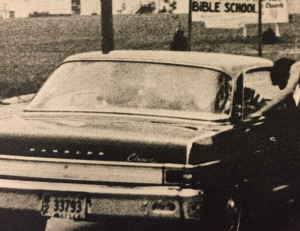 Sherry: My first car was an old car my parents gave me in the late seventies, after letting me drive it during most of my high school years and on and off in college. It was a 1965 Rambler that a friend nicknamed “Rodney”. I drove it to Grand Junction, Colorado in 1981 when I moved there. I kept it another two years before finally selling it. Part of me believes that car is still on the road somewhere.
Sherry: My first car was an old car my parents gave me in the late seventies, after letting me drive it during most of my high school years and on and off in college. It was a 1965 Rambler that a friend nicknamed “Rodney”. I drove it to Grand Junction, Colorado in 1981 when I moved there. I kept it another two years before finally selling it. Part of me believes that car is still on the road somewhere.
The picture above is from my high school year book. I was editor in chief my senior year so Rodney became a prop for one of the photos. My favorite car was the Cutlass Supreme my family bought when I was in high school. It was hot and fast. I got to drive it on occasion but usually it was Rodney and me.
Jessie: I had a Ford Tempo as a first car and I loved it. It had a sunroof, and a leather wrapped steering wheel. It was a standard and I loved working my way up and down through the gears. I liked it so much I’ve chosen standards every time it has been an option since, including my current favorite, a little red Mini Cooper.
Edith: Ah, fond memories. I was a pump jock and apprentice mechanic at Lockhart’s 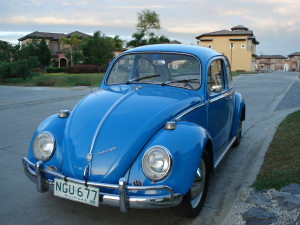 Mobil on Coast Highway in Newport Beach, California, with my freshly minted BA in linguistics. I saved up my money and bought a 66 bug very much like this one for $600. I did all the repairs myself, including once putting a fan belt on too tight and nearly burning up something or other. Still love the sound and feel of a good old analog engine. I’m with you, Jessie, on manual transmissions. The first automatic I’ve ever owned is my current Prius, and that’s only because they don’t make them with a stick shift. Favorite? I love getting mpgs in the high 50s with my current ride, but I also loved my 1970 Volvo sedan that I bought in 1980. The trunk was infinitely large, and the huge steering wheel made me feel like I was driving a bus, even though I had to sit on two pillows to see over it.
Mobil on Coast Highway in Newport Beach, California, with my freshly minted BA in linguistics. I saved up my money and bought a 66 bug very much like this one for $600. I did all the repairs myself, including once putting a fan belt on too tight and nearly burning up something or other. Still love the sound and feel of a good old analog engine. I’m with you, Jessie, on manual transmissions. The first automatic I’ve ever owned is my current Prius, and that’s only because they don’t make them with a stick shift. Favorite? I love getting mpgs in the high 50s with my current ride, but I also loved my 1970 Volvo sedan that I bought in 1980. The trunk was infinitely large, and the huge steering wheel made me feel like I was driving a bus, even though I had to sit on two pillows to see over it.
Julie: My first car was a Ford Escort, inherited from my grandmother. I drove it into the ground, but was in my 30’s when I inherited it, and have only had one car since, my Scion xB, which I adore. (I live in the Boston area, and use my feet and the T for my primary transport.) My 10 year old Scion just hit 40,000, so I suspect this might be it for a while.
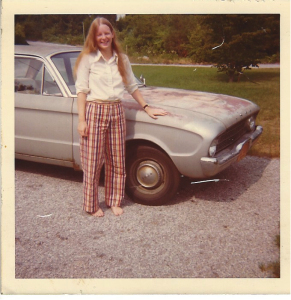 Barb: My first car was not even really mine. It was an ancient Ford Falcon that my grandfather left at the train station from Monday morning until Thursday night when he returned from Manhattan to my grandparents’ summer home in Water Mill, Long Island. In the summer of 1974, I lived with them , and I got the use of the car as long as I dropped him off and picked him up at the train. The Ford was ancient even then (see the rust) and had no power steering. When I went to see my boyfriend in Boston (now my husband), I would take two small ferries that went to and from Shelter Island. The ferrymen, who got used to seeing this college girl in the old beater, delighted in having me park it in the most impossible spots on the boat. They thought it was hilarious to watch me grapple with the wheel. My favorite car was the same grandparents 1958 Thunderbird. White with real leather seats in white and aqua. When Bill and I were in Cuba in 2013, I got to ride in one again. A real trip down memory lane.
Barb: My first car was not even really mine. It was an ancient Ford Falcon that my grandfather left at the train station from Monday morning until Thursday night when he returned from Manhattan to my grandparents’ summer home in Water Mill, Long Island. In the summer of 1974, I lived with them , and I got the use of the car as long as I dropped him off and picked him up at the train. The Ford was ancient even then (see the rust) and had no power steering. When I went to see my boyfriend in Boston (now my husband), I would take two small ferries that went to and from Shelter Island. The ferrymen, who got used to seeing this college girl in the old beater, delighted in having me park it in the most impossible spots on the boat. They thought it was hilarious to watch me grapple with the wheel. My favorite car was the same grandparents 1958 Thunderbird. White with real leather seats in white and aqua. When Bill and I were in Cuba in 2013, I got to ride in one again. A real trip down memory lane.
Readers, how about your firsts and favorites?
Filed under: Wicked Wednesday Tagged: 1958 Thunderbird, 1966 VW bug, 1970 Volvo, Chevy Cavalier, favorite cars, favorite vehicles, first cars, Ford Falcon, Ford Tempo, Jetta, Prius, Rambler, Volkswagon

April 14, 2015
Setting a Place
Jane/Susannah here, whose dream of spring has finally come true…
 Hello, my Wicked Lovelies. Or are you Lovely Wickeds? It’s only been a month, but it seems like forever since I’ve posted. This coming weekend I’ll be giving a talk about cozy mysteries at the Mark Twain House and Museum in Hartford, Connecticut, as part of their 4th Annual Writers’ Weekend. (There are still tickets available, for the whole conference, individual days, and even individual classes. Click here for more information)
Hello, my Wicked Lovelies. Or are you Lovely Wickeds? It’s only been a month, but it seems like forever since I’ve posted. This coming weekend I’ll be giving a talk about cozy mysteries at the Mark Twain House and Museum in Hartford, Connecticut, as part of their 4th Annual Writers’ Weekend. (There are still tickets available, for the whole conference, individual days, and even individual classes. Click here for more information)
In putting together my presentation, I thought long and hard about what makes a mystery cozy. And I came to a conclusion that surprised me. Before I started my analysis, I would have said that the number one element of a traditional mystery is a relatable, likeable, mostly believeable heroine (or hero, if you want to be a rebel). After all, the reader is going to be spending quite a bit of time with that character, and doing the sleuthing right along with her, for several–hopefully many–books. I say mostly believable because really, how could any one person find that many bodies? But that’s why it’s fiction.
But by the time I’d thought longerer and harderer, I realized that setting is more important than the protagonist, more important even than the plot. Yup, you read that right. It seems to go against everything we’ve learned about craft as it relates to character-driven genre fiction, doesn’t it? But hear me out.
My Greek to Me Mystery Series is set in the Thousand Islands region of New York State. The area is distinctive, with its own natural beauty and cultural dynamic. I grew up there, so I know it well. It was a no-brainer for me to set my series there. But now that I’m examining the series more closely, mining it for material for my presentation, I’ve decided that anybody in my fictional town of Bonaparte Bay could solve a mystery, if I let her/him. There’s nothing so unique or special about my heroine, Georgie, that she’s the only person who could get to the bottom of whatever’s going on. This is fascinating to me. Georgie’s the sleuth we read about, and hopefully connect with, and yet, she’s sort of dispensible. I hope she’s interesting and well-drawn enough that readers want to learn more about her and follow her on her adventures through the series.
But the truth is, she can’t do her sleuthing without the foundation, the setting, propping her up. Take her out of Bonaparte Bay and put her in New York City, for example, and she’d have a tough time figuring out which subway line to take, let alone figuring out who killed that guy on the train and why. She can solve mysteries in Bonaparte Bay because she understands the community she lives in–her setting.
Likewise, the plot, which you might think would also be a candidate for Most Important Element of a Mystery, is also secondary to the setting. Because cozy mystery plots all hinge on one thing: they happen in the setting they do, because that’s the only place they can happen. That sounds like circuitous logic, but the fact is, in a cozy mystery, it’s almost always a character residing in the community who commits the crime. Often, it’s a member of the community who is the victim, though there’s more flexibility there to bring in an outsider. This is no accident. When the killer is revealed to be a member of the community to which the reader has grown attached, our sense of outrage, of betrayal, is heightened. But take those two characters, victim and killer, and move them to a different stage, and you have a completely different story.
How about another example? Think of the book Rebecca by Daphne DuMaurier (and if you have not read it–do so immediately!). That plot, that unnamed heroine, can only exist as they do because they are superimposed on the framework of Manderley, Max de Winter’s English estate. What about Wuthering Heights? Would that have been the same story if it had been set in London instead of the remote English moors?
Do you agree with me? Do you have to start with setting and build from there? Or can you create a cozy mystery sleuth and then place her in a setting?
Filed under: Craft, Jane's posts, Susannah's posts, Uncategorized Tagged: Feta Attraction, Greek to Me Mysteries, Rebecca, setting, Susannah Hardy, Thousand Islands, Wuthering Heights

April 13, 2015
Finding Ten Thousand Words
Edith here, nearly delirious with our warming trend, the vanishing of the last piles of snow,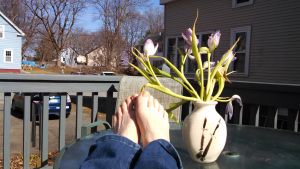 the ability to sun my tootsies, and all the little green things popping out of the ground. Must schedule a pedicure!
the ability to sun my tootsies, and all the little green things popping out of the ground. Must schedule a pedicure!
Before my surgery (which went very well, thank you, and from which I am healing alarmingly fast), I finished the first draft of Grilled for Murder, the second local foods mystery, due August 1. Unfortunately, it was about ten thousand words short of the minimum specified in my Kensington contract, 75000.
This often happens with my first drafts, which tend to be a bit, well, sparse, so I wasn’t too worried about it. Within a week of my surgery I found I could sit and type for extended periods, so I am back at work finding ten thousand words. How do I do that?
The easiest way would be to realize I needed five more scenes here and there, so I went looking. I did find one empty scene, which I had labeled Thursday Lunch. My note card for it read, “Bring Tanya back in. What happens?” Oh. That wasn’t very helpful. But I started writing, brought Tanya back in, and a day later had a nice 1200-word scene with several elements of suspense and suspicion, and which connected with something I’d already written that happens later that day.
1200 down, 8800 to go. I didn’t really see any other obvious gaps in the story, though. Back to that sparseness thing. I started reading through every scene to make sure I’d  included at least several senses. What does the hardware store smell like? Did I describe how the air felt on Robbie’s skin during one of her long bike rides? What did the villain’s hair look like in the final action scene? How did Abe’s rabbit stew taste at the Hoosier Hollow restaurant? And so on. That process added a couple thousand words.
included at least several senses. What does the hardware store smell like? Did I describe how the air felt on Robbie’s skin during one of her long bike rides? What did the villain’s hair look like in the final action scene? How did Abe’s rabbit stew taste at the Hoosier Hollow restaurant? And so on. That process added a couple thousand words.
I went looking for fun southern expressions that a couple of my characters can use, and found some like “Well, butter my butt and call me a biscuit,” “Easier than sliding off a greasy log backwards,” and “He’s busier than a one-legged man in a butt-kicking contest.”
Another trend of mine is forgetting to have people reflect, especially my protagonists. A typical refrain from my critique group is, “Wouldn’t she be thinking about what happened in the last scene?” So I did a pass through looking for that. Another 500 words. Next I’ll check all the areas that Chris Roerden mentions in her excellent, Don’t Murder Your Mystery and see what else I can fix, and make sure I’ve tied off all the red herrings and subplots.
In the process of successive read-throughs and fixes, I’m up to 69,111, with plenty of time to go. I know after I hand it off to my brilliant and trusty editor, Sherry, for a pass before I send it to my editor at Kensington, she’ll find gaps in the story I need to fill, too. I’ll also need a trimming pass as well, of course, eliminating trite words and dull language.
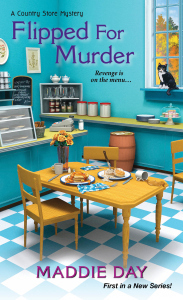 I know I’ll get to that magic 75000 words as I keep working on the story. If I’m a little short (hey, no jokes!), I don’t think they’ll mind too much. And remember, you can already preorder book one, Flipped for Murder!
I know I’ll get to that magic 75000 words as I keep working on the story. If I’m a little short (hey, no jokes!), I don’t think they’ll mind too much. And remember, you can already preorder book one, Flipped for Murder!
Readers, how do you achieve the quantity you need, in writing or elsewhere in your life? Other tips for fleshing out a story? Readers, would you rather see a short cozy or a longer one? And how’s spring by you?
Filed under: Edith's posts Tagged: Chris Roerden, Country Store Mysteries, Flipped for Murder, Maddie Day



